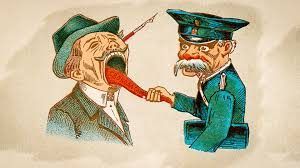Donald Rayfield at Literary Review:
 In 1905, defeated by Japan and facing insurrection in the major cities and financial catastrophe, Russia’s tsar and his government were forced to retreat from autocracy and create a parliament (the Duma). Censorship, already weak and inconsistent, virtually collapsed. By then, there were plenty of printing presses, legal and illegal, along with cheap paper and card and, most surprisingly, an efficient postal system of a kind that modern Russians can only dream of. Moscow and St Petersburg had six collections a day; a letter sent from the Crimea to France took just four days to arrive. By 1913 Moscow alone handled thirteen million letters a year. Postcards, first introduced in 1872, were the cheapest form of communication – a mere three-kopeck stamp took a card anywhere in the empire. It was some time before cards could be illustrated, and it was later still that it became no longer obligatory to confine the message to a line or two scrawled over the illustration. Regulations eventually relaxed so much that giant postcards much larger than the standard 9 x 14 cm were accepted.
In 1905, defeated by Japan and facing insurrection in the major cities and financial catastrophe, Russia’s tsar and his government were forced to retreat from autocracy and create a parliament (the Duma). Censorship, already weak and inconsistent, virtually collapsed. By then, there were plenty of printing presses, legal and illegal, along with cheap paper and card and, most surprisingly, an efficient postal system of a kind that modern Russians can only dream of. Moscow and St Petersburg had six collections a day; a letter sent from the Crimea to France took just four days to arrive. By 1913 Moscow alone handled thirteen million letters a year. Postcards, first introduced in 1872, were the cheapest form of communication – a mere three-kopeck stamp took a card anywhere in the empire. It was some time before cards could be illustrated, and it was later still that it became no longer obligatory to confine the message to a line or two scrawled over the illustration. Regulations eventually relaxed so much that giant postcards much larger than the standard 9 x 14 cm were accepted.
more here.
